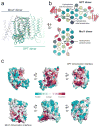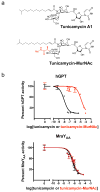GlcNAc-1-P-transferase-tunicamycin complex structure reveals basis for inhibition of N-glycosylation
- PMID: 29459785
- PMCID: PMC5840018
- DOI: 10.1038/s41594-018-0031-y
GlcNAc-1-P-transferase-tunicamycin complex structure reveals basis for inhibition of N-glycosylation
Abstract
N-linked glycosylation is a predominant post-translational modification of protein in eukaryotes, and its dysregulation is the etiology of several human disorders. The enzyme UDP-N-acetylglucosamine:dolichyl-phosphate N-acetylglucosaminephosphotransferase (GlcNAc-1-P-transferase or GPT) catalyzes the first and committed step of N-linked glycosylation in the endoplasmic reticulum membrane, and it is the target of the natural product tunicamycin. Tunicamycin has potent antibacterial activity, inhibiting the bacterial cell wall synthesis enzyme MraY, but its usefulness as an antibiotic is limited by off-target inhibition of human GPT. Our understanding of how tunicamycin inhibits N-linked glycosylation and efforts to selectively target MraY are hampered by a lack of structural information. Here we present crystal structures of human GPT in complex with tunicamycin. Structural and functional analyses reveal the difference between GPT and MraY in their mechanisms of inhibition by tunicamycin. We demonstrate that this difference could be exploited to design MraY-specific inhibitors as potential antibiotics.
Conflict of interest statement
Figures





Similar articles
-
Structural basis for selective inhibition of antibacterial target MraY, a membrane-bound enzyme involved in peptidoglycan synthesis.Drug Discov Today. 2018 Jul;23(7):1426-1435. doi: 10.1016/j.drudis.2018.05.020. Epub 2018 May 18. Drug Discov Today. 2018. PMID: 29778697 Review.
-
[Bridge between Total Synthesis of Bioactive Natural Products and Development of Drug Leads].Yakugaku Zasshi. 2022;142(4):355-363. doi: 10.1248/yakushi.21-00185-2. Yakugaku Zasshi. 2022. PMID: 35370192 Review. Japanese.
-
Structures of Bacterial MraY and Human GPT Provide Insights into Rational Antibiotic Design.J Mol Biol. 2020 Aug 21;432(18):4946-4963. doi: 10.1016/j.jmb.2020.03.017. Epub 2020 Mar 19. J Mol Biol. 2020. PMID: 32199982 Free PMC article. Review.
-
Exploring the Active Site of the Antibacterial Target MraY by Modified Tunicamycins.ACS Chem Biol. 2020 Nov 20;15(11):2885-2895. doi: 10.1021/acschembio.0c00423. Epub 2020 Nov 9. ACS Chem Biol. 2020. PMID: 33164499
-
Modeling bacterial UDP-HexNAc: polyprenol-P HexNAc-1-P transferases.Glycobiology. 2005 Sep;15(9):29R-42R. doi: 10.1093/glycob/cwi065. Epub 2005 Apr 20. Glycobiology. 2005. PMID: 15843595 Review.
Cited by
-
Intermolecular Interactions of Nucleoside Antibiotic Tunicamycin with On-Target MraYCB-TUN and Off-Target DPAGT1-TUN in the Active Sites Delineated by Quantum Mechanics/Molecular Mechanics Calculations.ACS Omega. 2022 Sep 6;7(37):32970-32987. doi: 10.1021/acsomega.2c02213. eCollection 2022 Sep 20. ACS Omega. 2022. PMID: 36157785 Free PMC article.
-
The surprising structural and mechanistic dichotomy of membrane-associated phosphoglycosyl transferases.Biochem Soc Trans. 2021 Jun 30;49(3):1189-1203. doi: 10.1042/BST20200762. Biochem Soc Trans. 2021. PMID: 34100892 Free PMC article. Review.
-
Quantitative Measurement of Transthyretin Mistargeting by Proximity Labeling and Parallel Reaction Monitoring.Front Chem Biol. 2023;2:1288188. doi: 10.3389/fchbi.2023.1288188. Epub 2023 Nov 9. Front Chem Biol. 2023. PMID: 38173467 Free PMC article.
-
Visualizing conformation transitions of the Lipid II flippase MurJ.Nat Commun. 2019 Apr 15;10(1):1736. doi: 10.1038/s41467-019-09658-0. Nat Commun. 2019. PMID: 30988294 Free PMC article.
-
The Crucial Role of Demannosylating Asparagine-Linked Glycans in ERADicating Misfolded Glycoproteins in the Endoplasmic Reticulum.Front Plant Sci. 2021 Jan 12;11:625033. doi: 10.3389/fpls.2020.625033. eCollection 2020. Front Plant Sci. 2021. PMID: 33510762 Free PMC article. Review.
References
-
- Lehrman MA. Biosynthesis of N-acetylglucosamine-P-P-dolichol, the committed step of asparagine-linked oligosaccharide assembly. Glycobiology. 1991;1:553–562. - PubMed
Publication types
MeSH terms
Substances
Grants and funding
LinkOut - more resources
Full Text Sources
Other Literature Sources
Medical
Molecular Biology Databases

